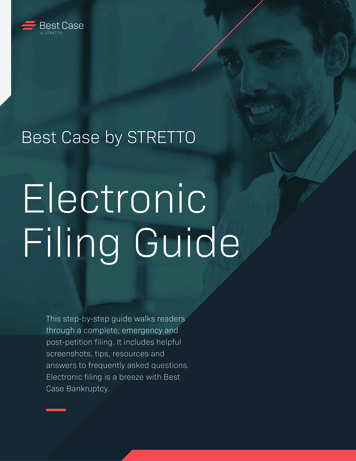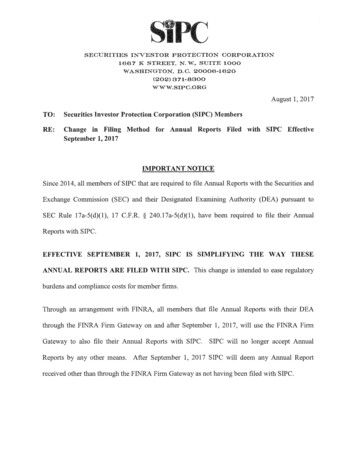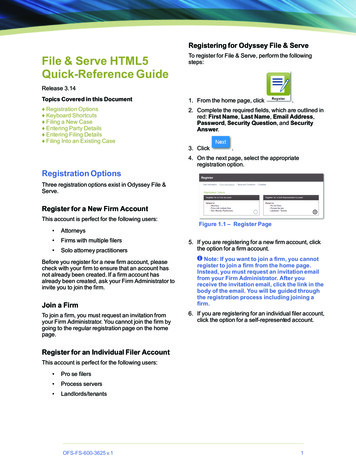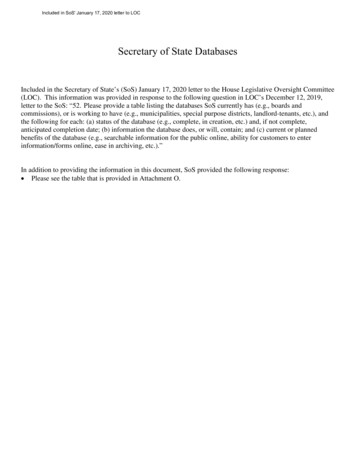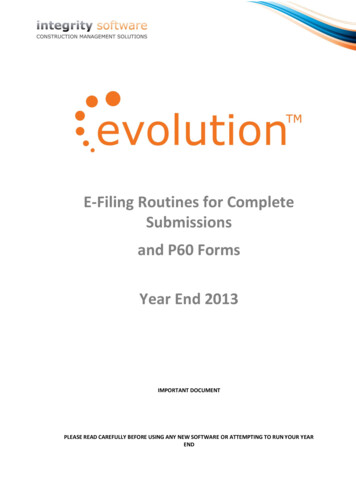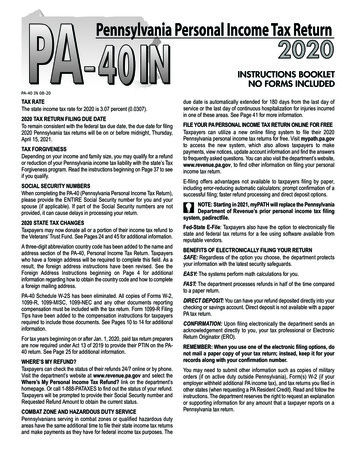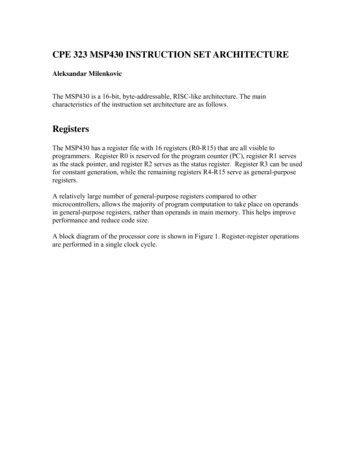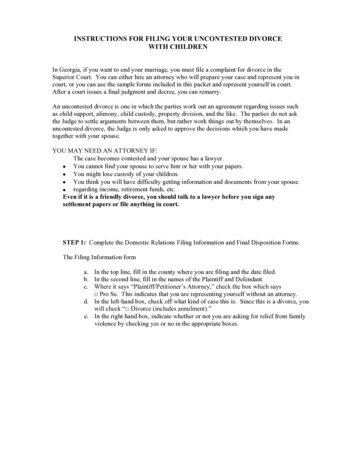
Transcription
INSTRUCTIONS FOR FILING YOUR UNCONTESTED DIVORCEWITH CHILDRENIn Georgia, if you want to end your marriage, you must file a complaint for divorce in theSuperior Court. You can either hire an attorney who will prepare your case and represent you incourt, or you can use the sample forms included in this packet and represent yourself in court.After a court issues a final judgment and decree, you can remarry.An uncontested divorce is one in which the parties work out an agreement regarding issues suchas child support, alimony, child custody, property division, and the like. The parties do not askthe Judge to settle arguments between them, but rather work things out by themselves. In anuncontested divorce, the Judge is only asked to approve the decisions which you have madetogether with your spouse.YOU MAY NEED AN ATTORNEY IF:The case becomes contested and your spouse has a lawyer.You cannot find your spouse to serve him or her with your papers.You might lose custody of your children.You think you will have difficulty getting information and documents from your spouseregarding income, retirement funds, etc.Even if it is a friendly divorce, you should talk to a lawyer before you sign anysettlement papers or file anything in court.STEP 1: Complete the Domestic Relations Filing Information and Final Disposition Forms.The Filing Information forma. In the top line, fill in the county where you are filing and the date filed.b. In the second line, fill in the names of the Plaintiff and Defendant.c. Where it says “Plaintiff/Petitioner’s Attorney,” check the box which says Pro Se. This indicates that you are representing yourself without an attorney.d. In the left-hand box, check off what kind of case this is. Since this is a divorce, youwill check “ Divorce (includes annulment).”e. In the right hand box, indicate whether or not you are asking for relief from familyviolence by checking yes or no in the appropriate boxes.
The Final Disposition formThe purpose of this form is to tell how your case ends. Since you case is far from over,you should NOT fill in the information in the three big boxes at the bottom of the page. At thispoint, we do not know how the case will end.a. In the top line, fill in only the county where you are filing. We do not yet know thedate disposed, since you have not yet received a final order from the Judge.b. Leave the second line, “Docket #,” blank. The clerk will assign this number.c. Write your name where it says “Reporting party.”d. Write down the full names of the Plaintiff and Defendant.e. Where it says Plaintiff/Petitioner’s Attorney, you will check the box which says Pro Se. This shows that you are representing yourself. Since you are not a licensedattorney, you do not have a Bar #, so leave those blanks empty.STEP 2: Complete the Complaint for Divorce.Fill in your full name as the Plaintiff and your spouse’s full name as Defendant. Do not fillin where it says Civil Action File No. The clerk will assign a number to your case whenyou file your complaint. Then insert your name in the space provided just before paragraphone (1).Paragraph 1: Subject Matter JurisdictionCheck box a) if you have lived in the state of Georgia for at least six months prior to filingyour complaint for divorce.Check box b) if you are not a resident of the state of Georgia, but your spouse has lived inGeorgia and in the county where you are filing for at least six months prior to your filing thecomplaint for divorce. If neither a) or b) applies to you, you cannot file for divorce in thiscounty.Paragraph 2: Venue and ServiceAcknowledgement of ServiceCheck box a) if your spouse will sign an Acknowledgement of Service. You will need togive your spouse of copy of your completed Complaint for Divorce and have him/her sign theAcknowledgement of Service. By signing this form, your spouse is letting the court knowthat he/she has received a copy of your petition and, therefore, will not need to be served witha copy of your petition by the sheriff.Waiver of Venue and Jurisdiction and Acknowledgement of ServiceCheck box b) if:your spouse lives in Georgia but does not live in the county where you are filing; oryour spouse lives in another state and will consent (agree) to let you file for divorcein Georgia.
Paragraph 3: Date of MarriageCheck box a) if you and your spouse have a marriage certificate. Insert the date you weremarried in the space provided.Check box b if you and your spouse are common law married. Insert the date you and yourspouse entered into your marriage in the space provided. You were common law married if thefollowing statements are true:1. You and your spouse were able to enter into a contract at the time you established acommon law marriage. You were over age sixteen and mentally competent.2. You and your spouse actually entered into a contract of marriage meaning that you andyour spouse agreed that you were married.3. You and your spouse have had sexual intercourse.4. All of the above were done before January 1, 1997.Paragraph 4: Date of SeparationInsert in the space provided the date you and your spouse separated. It is not essentialthat the husband or wife leave the marital homeplace; separation can occur when one spousemoves into another room with the intent and purpose of suspending conjugal rights. Thesuspended conjugal rights include the company, cooperation, assistance, aid and intimacy of theother spouse in every conjugal way.Paragraph 5: ChildrenCheck the box underneath paragraph 5. List all children born to you and your spouse together,even if the children were born before your marriage. List the child (ren)’s name(s), date(s) ofbirth(s), and sex(es).Paragraph 6: CustodyCheck box a) if you want one party to have sole legal and physical custody, while the other partyretains only the right to visitation.Check box b) if you intend for the parties to share legal custody, but for one party to have primaryphysical custody (in other words, the children will live with one party most of the time).Check box c) if you intend for the parties to share both legal and physical custody. In the blanksprovided, explain how the custody will be divided up. Possible options include: six months witheach party, every other week with each party; half of each week with each party, etc.Paragraph 7: Children’s Place of ResidenceInsert in the space provided the addresses of where the children lived, the dates they lived at eachplace, and the names of who they lived with.
Paragraph 8: Other Actions Concerning the ChildrenCheck box a) if there has never been any other actions concerning your child(ren). The courtwants to know about the following types of actions: custody, visitation, family violence,protective orders, termination of parental rights, and adoption.Check box b) if there has ever been or is presently another action concerning your chid(ren). Thecourt wants to know about the following types of actions: custody, visitation, family violence,protective orders, termination of parental rights, and adoption. Insert in the space provided thelocation of the action, the type of action, when it began, and what happened at that action.Paragraph 9: Other Persons with Custody ClaimsCheck box a) if no one other than you or your spouse has a court order stating what legal rightsthey have to your child(ren). This means that there is no court order granting anyone else custodyor guardianship of your child.Check box b) if someone other than you or your spouse has any legal rights to your child(ren).Insert in the space provided the name of the person or agency, and what legal rights that person oragency has to your children.Paragraph 10: Grounds for DivorceThis uncontested divorce packet uses the most common ground for divorce, that the marriage is“irretrievably broken.” This means that you and your spouse are unable to live together, andthere is no hope that the two of you will get back together again. This is what is commonly calleda “no fault” divorce.Paragraph 11: Settlement AgreementCheck the box beside paragraph 11 to indicate that you have signed a settlement agreement withyour spouse.STEP 3: SummonsComplete the Summons form. Insert your name as Plaintiff and your spouse's name asDefendant. Do not fill in where it says Civil Action File No. The Clerk will assign a number toyour case when you file your complaint. A Summons form must be filled out by Plaintiff andfiled with the Clerk of Court. If the Defendant is served by the Sheriff, then the Summons formmust be included with the complaint for service. The Summons notifies the Defendant that ifan answer is not filed with the Court within 30 days of service, then a judgment by default canbe entered against the Defendant.STEP 4: VerificationComplete the Verification form. Insert your name as Plaintiff and your spouse’s name asDefendant. Do not fill in where it says Civil Action File No. The clerk will assign a number toyour case when you file your complaint. You will need to sign this Verification in the presenceof a Notary Public. Most banks and many libraries have a notary on staff and will notarize yourdocuments for a small fee.
STEP 5: Settlement AgreementThe Caption: Fill in the name of the county in which you are filing. Fill in the names of thePlaintiff and the Defendant. Leave the Civil Action No. blank empty; the Clerk of Court willassign a number to the case.Introductory paragraph: insert the names of the husband and wife.Paragraph 1: Separationanother.Check the box beside paragraph one to indicate your intentions to live apart from oneParagraph 2: Non-interference with parental relationshipsCheck the box beside paragraph two to show that you intend to encourage a positiverelationship between the child(ren) and the other party.Paragraph 3: Legal and Physical CustodyLegal custody means the authority to make decisions about the children. Physicalcustody means the physical care of the children—who are the children living with. There arethree ways to divide up custody:Sole legal and physical custody. In this arrangement, one parent assumes the decisionmaking responsibility, and the children spend most of their time with that parent.Shared legal custody and sole physical custody. Parents share decision-making authority, butthe children spend most of their time with only one parent. There is often a provision that inthe event of a disagreement about a decision, one parent will be the “tie-breaker.”Shared legal custody and shared physical custody. Parents share decision-making authority,and the children divide their time equally between their parents.Check box a) if you intend for one parent to have sole legal and physical custody.Check box b) if you intend for the parents to share legal custody, but for one parent to have solephysical custody. In the blanks provided, explain any details of your arrangement for primaryphysical custody. If you want for one party to have secondary physical custody, check the boxand explain the details of your arrangement.Check box c) if you intend for the parents to share both legal and physical custody. In the blanksprovided, explain the details of your arrangement for sharing physical custody. If you want tohave a tie-breaker in the event of a disagreement, check the boxes to indicate who the tie-breakerwill be. If you want to limit the tie-breaker provision only to certain issues, write down whatthose issues are.Paragraph 4: VisitationChoose a) if you want to draft your own visitation schedule. Write the schedule down in theblanks provided. You may attach additional pages if necessary.Choose b) if you want to use the visitation schedule included in this packet.Paragraph 5: Child Support AmountThe first step in calculating child support is to complete the required Child Support Worksheets.You can find the worksheet at http://www.georgiacourts.org/csc/. You can find training materialsfor further help at http://www.georgiacourts.org/csc/training.html . You must include your print copy of theWorksheet
with the papers you file. If you fail to include this Worksheet, the Clerk’s Office will refuse tofile your papers.Now that you have completed the required Child Support Worksheet, you can fill out Paragraph 5of the Settlement Agreement. Check the boxes to indicate which parent is making the paymentsand which parent is receiving the payments. In the blank provided, insert the amount of childsupport which you came up with after filling out the Child Support Worksheet. .In the blank provided, insert the date on which the first child support payment should be received.Check the boxes to show how often the payments should be made. In the blank provided, explainhow the child support will be reduced as each child reaches the age of majority. For example, ifthe non-custodial parent must pay 400 per month for two children, for a total of 800 per month,you might say, “When Susie is no longer eligible for child support, the amount will be reduced to 400 per month for the support of Johnny as long as Johnny is still eligible for child support.”Paragraph 6: Child Support Method of PaymentCheck the box beside a) if you intend to have the non-custodial parent send payments directly tothe custodial parent. This provision allows for an income deduction order in the event thatpayments are late three or more times in any twelve month period.Check the box beside b) if you intend for child support to be paid through Georgia Child SupportEnforcement via an income deduction order.Paragraph 7: Health InsuranceCheck the box beside this paragraph. Check the box beside the party who will be responsible formaintaining health insurance for the benefit of the minor child(ren). In the blanks provided,specify how the costs not covered by the insurance policy will be divided up. Check the boxes toindicate both who should provide health insurance cards and who should cooperate in submittingclaims under the policy.Paragraph 8: AlimonyCheck a) if you agree to have alimony payments for the support of one of the parties. Check theboxes to show who is making payments to whom. In the blank provided, indicate the amount.Check the box beside week/month to indicate how often the payments should be made. In theblank provided, indicate the date on which the first payment should be made.Paragraph 9: Division of PropertyChoose box a) if you have no marital property to divide.Choose paragraph b) if you have already divided up your marital property to your mutualsatisfaction.Choose box c) if you have items of property to be divided. In the blanks provided, list what thoseitems are.Paragraph 10: Division of DebtsCheck box a) if you have no joint debts which should be divided.Check box b) if you have joint debts which need to be divided. In the chart provided, list thename of the creditor, the amount owed, and who will be responsible for the debt.
Paragraph 11: Name RestorationCheck the box beside this paragraph if a party wishes to be restored to a former surname or to amaiden name.Paragraph 12: Binding AgreementCheck the box beside this paragraph to show that this agreement was entered voluntarily withoutany external pressure.Paragraph 13: Entire UnderstandingCheck the box beside this paragraph to show that there are no agreements other than those listedin this document.Paragraph 14: EnforceabilityCheck the box beside this paragraph to show that you agree to be bound by this agreementwhether you maintain a separate maintenance or go on to get a divorce.SignaturesEach party must sign the Agreement in the presence of a notary public. The parties do not haveto sign at the same time, and they do not have to use the same notary public.STEP 6: Other Court DocumentsIn addition to the complaint for Divorce and the Verification, you will need to attach thefollowing forms to your complaint (they are in the packet):1. Completed financial affidavits2. Consent to Try within 31 Days3. Acknowledgement of Service [OR] Acknowledgement of Service, Affidavit of Waiver ofVenue and Personal Jurisdiction4. Final Ordera. Caption: Fill in your full name as the Plaintiff and your spouse’s full name asDefendant. Do not fill in where it says Civil Action File No. The clerk willassign a number to your case when you file your complaint.b. Contents of Order: (You will use the numbers from your Child SupportWorksheet)(1)Change of Name—In the first blank, fill in the current name ofthe spouse whose name will be changed. In the second blank, fill inthe name of that spouse as it will be after the change of name.Date of Settlement Agreement—Fill in the date on which the(2)settlement agreement was reached. If the husband and wife signed ondifferent days, use the later date.(3)Names of Children (Paragraph 1)—Fill in the names of thechildren and their dates of birth.(4)Name of Custodial Parent (Paragraph 2 a)—Fill in the name ofthe Custodial Parent.(5)Name of Non-custodial parent (Paragraph 2 b)—Fill in the nameof the Non-custodial parent.
(6)Parenting Time (Paragraph 2 c)—Fill in the number of dayswhich the non-custodial parent will visit with the child(ren).(7)Gross income of Husband (Paragraph 3 a)—Fill in the grossincome of the Husband.(8)Gross income of Wife (Paragraph 3 b)—Fill in the gross incomeof the Wife.(9)Non-custodial parent’s adjusted income (Paragraph 4 a)—Fill inthe adjusted income of the non-custodial parent.(10)Custodial Parent’s adjusted income (Paragraph 4 b)—Fill in theadjusted income of the custodial parent.(11)Combined adjusted income (Paragraph 4 c)—Fill in the amountof the parties’ combined adjusted income.(12)Basic Support Obligation (Paragraph 5)—Fill in the amount ofthe Basic Child Support Obligation which is listed on the “ChildSupport Obligation Schedule Table” based on the parties’ CombinedAdjusted Income. This table can be found 382.htm. Move thebar on the far right-hand side of the screen about one-third of the waydown the document in order to see this table.(13)Basic Child Support Obligation/Custodial Parent (Paragraph 6 a)Fill in the amount of the Basic Child Support Obligation for theCustodial parent.(14)Basic Child Support Obligation/Non-custodial parent (Paragraph6 b)—Fill in the amount for the Basic Child Support Obligation for theNon-custodial parent.(15)Health Insurance (Paragraph 7)—Check the box to show whetherhealth insurance is available at a reasonable cost. Fill in the name ofthe parent who is responsible for maintaining health insurance for thechildren.(16)Presumptive Amount of Child Support/Custodial Parent(Paragraph 8 a)—Fill in the Presumptive Amount of Child Support forthe Custodial parent.(17)Presumptive Amount of Child Support/Non-custodial Parent(Paragraph 8 b)—Fill in the Presumptive Amount of Child Support dueto the Non-custodial Parent.(18)Presumptive Amount of Child Support/Custodial Parent—Fill inthe Presumptive Amount of Child Support due to the Custodial Parent.(19)Title II Social Security Benefits (Paragraph 9)—Fill in theamount of benefits which the child receives each month under Title IIof the Federal Social Security Act on the Obligor’s account.(20)Special Circumstances (Paragraph 10)—Leave this areablank because the Judge has discretion on whether and how to usedeviations from the Presumptive Amount of Child Support. TheJudge will fill in this part of the Order.(21)Final Amounts (Paragraphs 11 and 12)—Leave these areasblank. If the Judge alters the Presumptive Amount of ChildSupport based on Special Circumstances, the final amounts maybe different from the numbers on your Child Support Worksheetsand Schedules.(22)Name of the Non-custodial Parent—Fill in the name of the NonCustodial Parent.
STEP 7: Produce the required financial documents.Along with the divorce packet, you must simultaneously file the following listed documents, aswell as a certificate of service showing that the documents were properly served on the otherparty, and indicating the date on which the documents were served:1. Complete the required Child Support Worksheets and Schedules by going tohttp://www.georgiacourts.org/csc/. If you need help with data entry on the Excelspreadsheet, you might want to find a bookkeeper to help you.2. Domestic Relations Financial Affidavit (included in this packet)3. All federal and state income tax returns, gift tax returns and intangible and personalproperty tax returns filed by the party or on the party’s behalf for the past three (3) years.4. IRS forms, W-2, 1099 and K-1 forms for the past year, if the income tax return for thatyear has not been prepared. Also, if such income tax return has not been prepared, ayear-ending pay stub received from the party’s employer should be provided.5. Pay stubs or other evidence of earned income for the twelve (12) months prior to thefiling of the action.6. A statement by the producing party identifying the amount and source of all incomereceived from all sources during the twelve (12) months preceding the filing of this actionif same is not reflected on the pay stubs produced.7. All loan applications and financial statements prepared or used within the three (3) yearspreceding the filing date of this action, whether used for the purpose of obtaining orattempting to obtain credit for any other purpose.8. The most recent statement for any liquid fund assets, including, but not limited to, profitsharing, 401-K, money market, stock and securities, bonds, accounts, retirement andpension plan.9. Corporate, partnership and trust tax returns for the last three (3) years, if the producingparty has an interest in a corporation, partnership, or trust greater than or equal to thirty(30%) percent.10. All written pre-marital or marital agreements entered into at any time between the partiesto this marriage, whether before or during the marriage.11. Any court orders directing a party to pay or receive spousal or child support, even ifreceived from a third party.ANY MATERIALLY FALSE STATEMENT KNOWINGLY MADE IN THESE DOCUMENTSWITH THE INTENT TO DEFRAUD OR MISLEAD SHALL SUBJECT ME TO THEPENALTY FOR PERJURY AND MAY BE CONSIDERED A FRAUD UPON THE COURT.STEP 8: Pay the filing fee.Unless you are able to have your filing fee waived, there is an filing fee in the Southern Judicial Circuit.You must pay this fee when you file your Complaint for Divorce unless you also file aPoverty Affidavit.STEP 9: File your forms.You should make two copies of all of your documents. Give the clerk your original and the twocopies. The clerk will assign a number to your case and will write in the number on yourdocuments. The clerk will then stamp the documents to show that your complaint has been filedand will give you your copy for your records. The original will remain with the court. The othercopy will be given to your spouse.
STEP 10: Attend the required seminar.Each of you must attend the seminar for parents regarding the effects of divorce on minorchildren afer the filing of this action and BEFORE you ask the Court to grant the divorce. ASeminar Schedule, together with fee requirements and locations, can be found in the Clerk of theSuperior Court’soffice. Seminar attendance by both parties is mandatory. Failure to complete this seminar in asuccessful manner will result in appropriate action against you by the Court, including denial ofthe grant of divorce until the class is completed, or the dismissal of your case.STEP 11: Receive the Final Judgment.If the Judge approves your settlement agreement, you should receive a copy of your finaljudgment in the mail. If the Judge has questions about matters contained in your documents,you may have a hearing. Your divorce is not final until the Judge signs the final order in thecase.
Paragraph 10: Grounds for Divorce This uncontested divorce packet uses the most common ground for divorce, that the marriage is “irretrievably broken.” This means that you and your spouse are unable to live together, and there is no hope that the two of you will get back together aga
